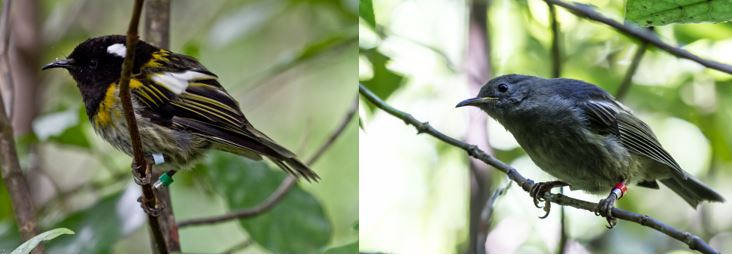Visitors to Shakespear Regional Park may be lucky to get a glimpse of the rare hihi (stitchbird) at Auckland’s most visited wildlife sanctuary this summer.
40 hihi – one of NZ’s rarest forest birds – have been translocated from the nearby Tiritiri Matangi Island to the regional park’s open sanctuary, which has become a pest-free haven for threatened native bird species and invertebrates.
They are small and fast but curiosity will often prompt the hihi to approach people. Matt Maitland, Auckland Council Senior Ranger Open Sanctuary, says birdwatchers should look out for a fantail-sized bird with a white wing bar and a high-pitched whistle. The male birds are easier to spot with a black head and flash of yellow on the neck.

Auckland Council, the Shakespear Open Sanctuary Society (SOSSI) and Ngāti Manuhiri Settlement Trust have worked in partnership over the past few months to achieve this significant conservation milestone, with support from the Hihi Conservation Charitable Trust, the Department of Conservation Hihi Recovery Group, and Supporters of Tiritiri Matangi.
In the late 1880s, hihi lived in multiple forest locations across the North Island but the only naturally surviving population now is on Te Hauturu-o-Toi / Little Barrier Island.
Since 2004, a North Island-focused recovery plan led by the Department of Conservation has been successful at establishing seven populations on predator-free islands and protected sanctuaries. But hihi recovery remains uncertain and recovery planning is guided by a strong adaptive management framework to learn and improve.
Mr Maitland says the project team is aiming to establish the eighth secure hihi population in New Zealand and the open sanctuary has all the factors needed for the translocation to succeed.
“There is high potential for this project to contribute to the overall conservation of hihi into the future so we are doing everything we can to get the setting right for success,” he says.
“The open sanctuary is already home to many well-known native birds including the korimako (bellbird), kākāriki (red-crowned parakeet), kererū (pigeon), ruru (morepork), kotare (kingfisher), pīwakawaka (fantail), tauhou (silvereye) and tūī. We hope the hihi will thrive alongside other species that have successfully been translocated like the kiwi pukupuku (little spotted kiwi), popokatea (whitehead), toutouwai (robin), and tīeke (North Island saddleback).”
Mr Maitland says each hihi will be closely monitored throughout the winter to ensure they are well fed with supplementary nectar and can access safe nesting boxes.
Councillor Richard Hills says the project provides another opportunity to acknowledge the dedication of rangers, external partners and the local community, who help to maintain the sanctuary’s effectiveness with ongoing pest control, monitoring and the restoration of native habitats.
“This network of passionate conservationists has consistently achieved zero predator control targets since a pest-proof fence was built in 2010. They are truly committed to protecting and conserving the precious biodiversity in this wildlife reserve that we are so lucky to have on our doorstep,”
“The time and effort that goes into protecting these taonga in Tāmaki Makaurau is impressive,” he adds.
All hihi whakapapa to Hauturu o Toi. Hihi are taonga to Ngāti Manuhiri, the iwi with an ancestral land connection to Hauturu, Tiritiri Matangi and Shakespear.
Ngāti Manuhiri Settlement Trust spokesperson Delma O’Kane says “as kaitiaki, we acknowledge the dedication of all involved in this kaupapa, from rangers and conservationists to the local community.
“It is through their unwavering commitment to pest control, monitoring, and habitat restoration that Shakespear Regional Park continues to thrive as a sanctuary for our native flora and fauna.”



